Argumentative Essay Guide
Argumentative Essay Outline

Argumentative Essay Outline: How to Structure Your Argumentative Essay
11 min read

People also read
The Ultimate Guide to Argumentative Essay Writing
250+ Argumentative Essay Topic Ideas To Help You Out
Argumentative Essay Examples: Samples & Tips
Learn the 3 Different Types of Argument and Multiple Argument Claims
Preparing to write an argumentative essay but don’t know where to start?
Making an outline is an important step in prewriting. Having a defined outline makes the essay writing process much simpler. It helps you logically present your ideas and saves you from getting stuck with writer’s block.
In this blog, we are going to teach you about how to write an outline for your essay. You’ll also get examples and templates to help you out.
So continue reading!
- 1. How To Write An Argumentative Essay Outline?
- 2. Types of Arguments and Argumentative Essay Outlines
- 3. Argumentative Essay Outline Examples
How To Write An Argumentative Essay Outline?
A simple argumentative essay outline follows the same structure as any other type of essay. The difference lies in the content of the body paragraphs. Unlike a persuasive essay, where the focus is on convincing the reader through emotional appeals, the argumentative essay presents the argument.
Some paragraphs introduce your own argument, while others state the opposing arguments and their refutations.
Here is an argumentative essay outline template you could follow for writing your essay:
The most common structure to craft an argumentative essay is as follows:
1. Argumentative Essay Introduction
The introductory paragraph introduces the main argument and provides a brief background of the argumentative essay topic you chose. Essay introductions act as a roadmap for the entire essay. For an argumentative essay, this is where you lay the foundation for your argument. An introduction comprises the following essential components:
- Hook Statement
A hook statement is written to grab the attention of your reader immediately. It should intrigue the reader and make them read the complete essay. For example, if you are writing an argumentative essay on animal testing, your hook statement could be:
- Background Information
Provide brief background information about your argument and the main claim of your essay. It will make it easier for the reader to understand the argument you will make in your essay. For example:
- Thesis Statement
An argumentative essay thesis statement should highlight your perspective, stance, and reason for your position. A thesis statement must be clearly defined, arguable, and defendable. It should express the importance of your argument and a reason why the reader should read your essay. For Example:
In case you're looking for some inspiration for your topic, check out our argumentative essay topics blog!
2. Argumentative Essay Supporting Paragraphs
In the body paragraph, you present your point of view and provide evidence that supports your argument. The goal here is to explain how valid your claim is by providing evidence that strengthens your argument.
For Example:
Here are four basic things that a body paragraph should state.
a. The purpose: Why are you making an argument about a particular issue?
b. Topic sentence: This is a fact or an example that helps the reader better understand your argument. The topic sentence of a paragraph should focus on just one point.
c. Provide evidence: State facts with examples and statistics that support your thesis statement and the topic sentence. Make sure that you have collected authentic evidence from credible sources.
d. Concluding sentence: The concluding sentence should reassert how the topic sentence helps the reader better understand the claim.
3. Argumentative Essay Counter Arguments Paragraph
The counter-argument is the other side of the issue that you will prove wrong by stating the specific reasons. In this paragraph, you mention the opposing views that the reader might pose against your argument and refute them. Conclude this paragraph by reasserting the thought provoking central idea of your essay.
4. Argumentative Essay Conclusion
A good argumentative essay conclusion summarizes the entire discussion of the essay and provides a call to action. It holds the same significance as the introduction paragraph. Here, you restate your thesis statement to remind the reader of your essay’s overall argument. Tell the reader that you have critically analyzed both sides of the argument. And based on the evidence, you have proved your side of the argument right. Explain the importance of your argument and bring your discussion to a logical end. You can propose a solution if your claim has specified a problem or make future predictions about the claim. Tell your reader the consequences if your argument is not believed and what good will happen if it's believed.
Here is an example:
Use the following argumentative essay outline graphic organizer to structure your essay efficiently.
Argumentative Essay Outline Graphic Organizer
Here’s a video demonstrating how you can prepare an argumentative essay outline:

Paper Due? Why Suffer? That's our Job!
Types of Arguments and Argumentative Essay Outlines
Your argumentative essay structure is affected by the type of argument you are using. There are three argumentative writing models: Classical, Rogerian, and Toulmin.
Let's take a look at each one:
Classical Argument
The classical argument is the oldest and most used argument model. It is based on the principles of rhetoric, which is the art of persuasion. This type of argument has a clear structure with distinct steps, making it an ideal choice for an essay or paper.
Here is the classical argumentative writing structure.
Classical Argumentative Essay Outline Template
Rogerian argument.
The Rogerian model allows both sides of an issue to be discussed to reach a common ground.
Unlike the classical approach, the Rogerian argument seeks to understand both sides of an issue before moving forward. This style of argumentation does not look for a single ‘right’ answer but seeks to create a dialogue between all parties.
Rhetorical Rogerian Argumentative Essay Outline Template
Toulmin argument.
The Toulmin argument is a model that breaks down an issue into its component parts to analyze it more thoroughly. The Toulmin argument is composed of six parts: a claim, grounds, warrant, backing, qualifier, and rebuttal.
The first part lays out the main point being argued (the “claim”) . This is followed by the evidence that supports it (the “grounds”) . It is then connected to an underlying assumption or principle (the “warrant”) .
The warrant is then supported by additional evidence (the “backing”) , which may be followed by qualifications (the “qualifier”) . Finally, the argument may anticipate and address possible counterarguments (the “rebuttal”) .
Toulmin Argumentative Essay Outline Template
Tough Essay Due? Hire Tough Writers!
Argumentative Essay Outline Examples
Argumentative Essay Outline Example PDF
Argumentative Essay Outline Worksheet
5 Paragraph Argumentative Essay Outline
MLA Argumentative Essay Outline
Conclusion Argumentative Essay Outline
Argumentative Essay Outline AP Lang
Vaccine Argumentative Essay Outline
Social Media Argumentative Essay Outline
Abortion Argumentative Essay Outline
Gun Control Argumentative Essay Outline
Need more sample essays to get a better idea? Give our argumentative essay examples a read!
The Bottom Line! We've covered all the essential elements of structuring your argumentative essay. With this guide, you're now well-prepared to craft a compelling essay that effectively presents your viewpoint and supports your argument with evidence.
Remember the key components: the introduction that hooks your reader, a clear thesis statement, well-organized body paragraphs, counterarguments, and a strong conclusion. Don't forget to cite your sources properly to give credibility to your work.
If you are unable to craft a perfect outline, you can always seek the help of an expert and professional essay writer at MyPerfectWords.com.
Our affordable argumentative essay writing service can help you write a top-notch argumentative paper. Our expert writers conduct research to find facts and evidence to support your claim and write an original essay according to your needs.
So reach out to our custom essay writing service today!

Write Essay Within 60 Seconds!

Nova Allison is a Digital Content Strategist with over eight years of experience. Nova has also worked as a technical and scientific writer. She is majorly involved in developing and reviewing online content plans that engage and resonate with audiences. Nova has a passion for writing that engages and informs her readers.

Paper Due? Why Suffer? That’s our Job!
Keep reading

Argumentative Essay Examples to Inspire You (+ Free Formula)
.webp)
Table of contents

Meredith Sell
Have you ever been asked to explain your opinion on a controversial issue?
- Maybe your family got into a discussion about chemical pesticides
- Someone at work argues against investing resources into your project
- Your partner thinks intermittent fasting is the best way to lose weight and you disagree
Proving your point in an argumentative essay can be challenging, unless you are using a proven formula.
Argumentative essay formula & example
In the image below, you can see a recommended structure for argumentative essays. It starts with the topic sentence, which establishes the main idea of the essay. Next, this hypothesis is developed in the development stage. Then, the rebuttal, or the refutal of the main counter argument or arguments. Then, again, development of the rebuttal. This is followed by an example, and ends with a summary. This is a very basic structure, but it gives you a bird-eye-view of how a proper argumentative essay can be built.

Writing an argumentative essay (for a class, a news outlet, or just for fun) can help you improve your understanding of an issue and sharpen your thinking on the matter. Using researched facts and data, you can explain why you or others think the way you do, even while other reasonable people disagree.
Free AI argumentative essay generator > Free AI argumentative essay generator >

What Is an Argumentative Essay?
An argumentative essay is an explanatory essay that takes a side.
Instead of appealing to emotion and personal experience to change the reader’s mind, an argumentative essay uses logic and well-researched factual information to explain why the thesis in question is the most reasonable opinion on the matter.
Over several paragraphs or pages, the author systematically walks through:
- The opposition (and supporting evidence)
- The chosen thesis (and its supporting evidence)
At the end, the author leaves the decision up to the reader, trusting that the case they’ve made will do the work of changing the reader’s mind. Even if the reader’s opinion doesn’t change, they come away from the essay with a greater understanding of the perspective presented — and perhaps a better understanding of their original opinion.
All of that might make it seem like writing an argumentative essay is way harder than an emotionally-driven persuasive essay — but if you’re like me and much more comfortable spouting facts and figures than making impassioned pleas, you may find that an argumentative essay is easier to write.
Plus, the process of researching an argumentative essay means you can check your assumptions and develop an opinion that’s more based in reality than what you originally thought. I know for sure that my opinions need to be fact checked — don’t yours?
So how exactly do we write the argumentative essay?
How do you start an argumentative essay
First, gain a clear understanding of what exactly an argumentative essay is. To formulate a proper topic sentence, you have to be clear on your topic, and to explore it through research.
Students have difficulty starting an essay because the whole task seems intimidating, and they are afraid of spending too much time on the topic sentence. Experienced writers, however, know that there is no set time to spend on figuring out your topic. It's a real exploration that is based to a large extent on intuition.
6 Steps to Write an Argumentative Essay (Persuasion Formula)
Use this checklist to tackle your essay one step at a time:

1. Research an issue with an arguable question
To start, you need to identify an issue that well-informed people have varying opinions on. Here, it’s helpful to think of one core topic and how it intersects with another (or several other) issues. That intersection is where hot takes and reasonable (or unreasonable) opinions abound.
I find it helpful to stage the issue as a question.
For example:
Is it better to legislate the minimum size of chicken enclosures or to outlaw the sale of eggs from chickens who don’t have enough space?
Should snow removal policies focus more on effectively keeping roads clear for traffic or the environmental impacts of snow removal methods?
Once you have your arguable question ready, start researching the basic facts and specific opinions and arguments on the issue. Do your best to stay focused on gathering information that is directly relevant to your topic. Depending on what your essay is for, you may reference academic studies, government reports, or newspaper articles.
Research your opposition and the facts that support their viewpoint as much as you research your own position . You’ll need to address your opposition in your essay, so you’ll want to know their argument from the inside out.
2. Choose a side based on your research
You likely started with an inclination toward one side or the other, but your research should ultimately shape your perspective. So once you’ve completed the research, nail down your opinion and start articulating the what and why of your take.
What: I think it’s better to outlaw selling eggs from chickens whose enclosures are too small.
Why: Because if you regulate the enclosure size directly, egg producers outside of the government’s jurisdiction could ship eggs into your territory and put nearby egg producers out of business by offering better prices because they don’t have the added cost of larger enclosures.
This is an early form of your thesis and the basic logic of your argument. You’ll want to iterate on this a few times and develop a one-sentence statement that sums up the thesis of your essay.
Thesis: Outlawing the sale of eggs from chickens with cramped living spaces is better for business than regulating the size of chicken enclosures.
Now that you’ve articulated your thesis , spell out the counterargument(s) as well. Putting your opposition’s take into words will help you throughout the rest of the essay-writing process. (You can start by choosing the counter argument option with Wordtune Spices .)

Counterargument: Outlawing the sale of eggs from chickens with too small enclosures will immediately drive up egg prices for consumers, making the low-cost protein source harder to afford — especially for low-income consumers.
There may be one main counterargument to articulate, or several. Write them all out and start thinking about how you’ll use evidence to address each of them or show why your argument is still the best option.
3. Organize the evidence — for your side and the opposition
You did all of that research for a reason. Now’s the time to use it.
Hopefully, you kept detailed notes in a document, complete with links and titles of all your source material. Go through your research document and copy the evidence for your argument and your opposition’s into another document.
List the main points of your argument. Then, below each point, paste the evidence that backs them up.
If you’re writing about chicken enclosures, maybe you found evidence that shows the spread of disease among birds kept in close quarters is worse than among birds who have more space. Or maybe you found information that says eggs from free-range chickens are more flavorful or nutritious. Put that information next to the appropriate part of your argument.
Repeat the process with your opposition’s argument: What information did you find that supports your opposition? Paste it beside your opposition’s argument.
You could also put information here that refutes your opposition, but organize it in a way that clearly tells you — at a glance — that the information disproves their point.
Counterargument: Outlawing the sale of eggs from chickens with too small enclosures will immediately drive up egg prices for consumers.
BUT: Sicknesses like avian flu spread more easily through small enclosures and could cause a shortage that would drive up egg prices naturally, so ensuring larger enclosures is still a better policy for consumers over the long term.
As you organize your research and see the evidence all together, start thinking through the best way to order your points.
Will it be better to present your argument all at once or to break it up with opposition claims you can quickly refute? Would some points set up other points well? Does a more complicated point require that the reader understands a simpler point first?
Play around and rearrange your notes to see how your essay might flow one way or another.
4. Freewrite or outline to think through your argument
Is your brain buzzing yet? At this point in the process, it can be helpful to take out a notebook or open a fresh document and dump whatever you’re thinking on the page.
Where should your essay start? What ground-level information do you need to provide your readers before you can dive into the issue?
Use your organized evidence document from step 3 to think through your argument from beginning to end, and determine the structure of your essay.
There are three typical structures for argumentative essays:
- Make your argument and tackle opposition claims one by one, as they come up in relation to the points of your argument - In this approach, the whole essay — from beginning to end — focuses on your argument, but as you make each point, you address the relevant opposition claims individually. This approach works well if your opposition’s views can be quickly explained and refuted and if they directly relate to specific points in your argument.
- Make the bulk of your argument, and then address the opposition all at once in a paragraph (or a few) - This approach puts the opposition in its own section, separate from your main argument. After you’ve made your case, with ample evidence to convince your readers, you write about the opposition, explaining their viewpoint and supporting evidence — and showing readers why the opposition’s argument is unconvincing. Once you’ve addressed the opposition, you write a conclusion that sums up why your argument is the better one.
- Open your essay by talking about the opposition and where it falls short. Build your entire argument to show how it is superior to that opposition - With this structure, you’re showing your readers “a better way” to address the issue. After opening your piece by showing how your opposition’s approaches fail, you launch into your argument, providing readers with ample evidence that backs you up.
As you think through your argument and examine your evidence document, consider which structure will serve your argument best. Sketch out an outline to give yourself a map to follow in the writing process. You could also rearrange your evidence document again to match your outline, so it will be easy to find what you need when you start writing.
5. Write your first draft
You have an outline and an organized document with all your points and evidence lined up and ready. Now you just have to write your essay.
In your first draft, focus on getting your ideas on the page. Your wording may not be perfect (whose is?), but you know what you’re trying to say — so even if you’re overly wordy and taking too much space to say what you need to say, put those words on the page.
Follow your outline, and draw from that evidence document to flesh out each point of your argument. Explain what the evidence means for your argument and your opposition. Connect the dots for your readers so they can follow you, point by point, and understand what you’re trying to say.
As you write, be sure to include:
1. Any background information your reader needs in order to understand the issue in question.
2. Evidence for both your argument and the counterargument(s). This shows that you’ve done your homework and builds trust with your reader, while also setting you up to make a more convincing argument. (If you find gaps in your research while you’re writing, Wordtune Spices can source statistics or historical facts on the fly!)

Get Wordtune for free > Get Wordtune for free >
3. A conclusion that sums up your overall argument and evidence — and leaves the reader with an understanding of the issue and its significance. This sort of conclusion brings your essay to a strong ending that doesn’t waste readers’ time, but actually adds value to your case.
6. Revise (with Wordtune)
The hard work is done: you have a first draft. Now, let’s fine tune your writing.
I like to step away from what I’ve written for a day (or at least a night of sleep) before attempting to revise. It helps me approach clunky phrases and rough transitions with fresh eyes. If you don’t have that luxury, just get away from your computer for a few minutes — use the bathroom, do some jumping jacks, eat an apple — and then come back and read through your piece.
As you revise, make sure you …
- Get the facts right. An argument with false evidence falls apart pretty quickly, so check your facts to make yours rock solid.
- Don’t misrepresent the opposition or their evidence. If someone who holds the opposing view reads your essay, they should affirm how you explain their side — even if they disagree with your rebuttal.
- Present a case that builds over the course of your essay, makes sense, and ends on a strong note. One point should naturally lead to the next. Your readers shouldn’t feel like you’re constantly changing subjects. You’re making a variety of points, but your argument should feel like a cohesive whole.
- Paraphrase sources and cite them appropriately. Did you skip citations when writing your first draft? No worries — you can add them now. And check that you don’t overly rely on quotations. (Need help paraphrasing? Wordtune can help. Simply highlight the sentence or phrase you want to adjust and sort through Wordtune’s suggestions.)
- Tighten up overly wordy explanations and sharpen any convoluted ideas. Wordtune makes a great sidekick for this too 😉

Words to start an argumentative essay
The best way to introduce a convincing argument is to provide a strong thesis statement . These are the words I usually use to start an argumentative essay:
- It is indisputable that the world today is facing a multitude of issues
- With the rise of ____, the potential to make a positive difference has never been more accessible
- It is essential that we take action now and tackle these issues head-on
- it is critical to understand the underlying causes of the problems standing before us
- Opponents of this idea claim
- Those who are against these ideas may say
- Some people may disagree with this idea
- Some people may say that ____, however
When refuting an opposing concept, use:
- These researchers have a point in thinking
- To a certain extent they are right
- After seeing this evidence, there is no way one can agree with this idea
- This argument is irrelevant to the topic
Are you convinced by your own argument yet? Ready to brave the next get-together where everyone’s talking like they know something about intermittent fasting , chicken enclosures , or snow removal policies?
Now if someone asks you to explain your evidence-based but controversial opinion, you can hand them your essay and ask them to report back after they’ve read it.
Share This Article:

The Official Wordtune Guide

An Expert Guide to Writing Effective Compound Sentences (+ Examples)

A Step-by-Step Guide to Writing a Stellar Literature Review (with Help from AI)
Looking for fresh content, thank you your submission has been received.

8 Effective Strategies to Write Argumentative Essays
In a bustling university town, there lived a student named Alex. Popular for creativity and wit, one challenge seemed insurmountable for Alex– the dreaded argumentative essay!
One gloomy afternoon, as the rain tapped against the window pane, Alex sat at his cluttered desk, staring at a blank document on the computer screen. The assignment loomed large: a 350-600-word argumentative essay on a topic of their choice . With a sigh, he decided to seek help of mentor, Professor Mitchell, who was known for his passion for writing.
Entering Professor Mitchell’s office was like stepping into a treasure of knowledge. Bookshelves lined every wall, faint aroma of old manuscripts in the air and sticky notes over the wall. Alex took a deep breath and knocked on his door.
“Ah, Alex,” Professor Mitchell greeted with a warm smile. “What brings you here today?”
Alex confessed his struggles with the argumentative essay. After hearing his concerns, Professor Mitchell said, “Ah, the argumentative essay! Don’t worry, Let’s take a look at it together.” As he guided Alex to the corner shelf, Alex asked,
Table of Contents
“What is an Argumentative Essay?”
The professor replied, “An argumentative essay is a type of academic writing that presents a clear argument or a firm position on a contentious issue. Unlike other forms of essays, such as descriptive or narrative essays, these essays require you to take a stance, present evidence, and convince your audience of the validity of your viewpoint with supporting evidence. A well-crafted argumentative essay relies on concrete facts and supporting evidence rather than merely expressing the author’s personal opinions . Furthermore, these essays demand comprehensive research on the chosen topic and typically follows a structured format consisting of three primary sections: an introductory paragraph, three body paragraphs, and a concluding paragraph.”
He continued, “Argumentative essays are written in a wide range of subject areas, reflecting their applicability across disciplines. They are written in different subject areas like literature and philosophy, history, science and technology, political science, psychology, economics and so on.
Alex asked,
“When is an Argumentative Essay Written?”
The professor answered, “Argumentative essays are often assigned in academic settings, but they can also be written for various other purposes, such as editorials, opinion pieces, or blog posts. Some situations to write argumentative essays include:
1. Academic assignments
In school or college, teachers may assign argumentative essays as part of coursework. It help students to develop critical thinking and persuasive writing skills .
2. Debates and discussions
Argumentative essays can serve as the basis for debates or discussions in academic or competitive settings. Moreover, they provide a structured way to present and defend your viewpoint.
3. Opinion pieces
Newspapers, magazines, and online publications often feature opinion pieces that present an argument on a current issue or topic to influence public opinion.
4. Policy proposals
In government and policy-related fields, argumentative essays are used to propose and defend specific policy changes or solutions to societal problems.
5. Persuasive speeches
Before delivering a persuasive speech, it’s common to prepare an argumentative essay as a foundation for your presentation.
Regardless of the context, an argumentative essay should present a clear thesis statement , provide evidence and reasoning to support your position, address counterarguments, and conclude with a compelling summary of your main points. The goal is to persuade readers or listeners to accept your viewpoint or at least consider it seriously.”
Handing over a book, the professor continued, “Take a look on the elements or structure of an argumentative essay.”
Elements of an Argumentative Essay
An argumentative essay comprises five essential components:
Claim in argumentative writing is the central argument or viewpoint that the writer aims to establish and defend throughout the essay. A claim must assert your position on an issue and must be arguable. It can guide the entire argument.
2. Evidence
Evidence must consist of factual information, data, examples, or expert opinions that support the claim. Also, it lends credibility by strengthening the writer’s position.
3. Counterarguments
Presenting a counterclaim demonstrates fairness and awareness of alternative perspectives.
4. Rebuttal
After presenting the counterclaim, the writer refutes it by offering counterarguments or providing evidence that weakens the opposing viewpoint. It shows that the writer has considered multiple perspectives and is prepared to defend their position.
The format of an argumentative essay typically follows the structure to ensure clarity and effectiveness in presenting an argument.
How to Write An Argumentative Essay
Here’s a step-by-step guide on how to write an argumentative essay:
1. Introduction
- Begin with a compelling sentence or question to grab the reader’s attention.
- Provide context for the issue, including relevant facts, statistics, or historical background.
- Provide a concise thesis statement to present your position on the topic.
2. Body Paragraphs (usually three or more)
- Start each paragraph with a clear and focused topic sentence that relates to your thesis statement.
- Furthermore, provide evidence and explain the facts, statistics, examples, expert opinions, and quotations from credible sources that supports your thesis.
- Use transition sentences to smoothly move from one point to the next.
3. Counterargument and Rebuttal
- Acknowledge opposing viewpoints or potential objections to your argument.
- Also, address these counterarguments with evidence and explain why they do not weaken your position.
4. Conclusion
- Restate your thesis statement and summarize the key points you’ve made in the body of the essay.
- Leave the reader with a final thought, call to action, or broader implication related to the topic.
5. Citations and References
- Properly cite all the sources you use in your essay using a consistent citation style.
- Also, include a bibliography or works cited at the end of your essay.
6. Formatting and Style
- Follow any specific formatting guidelines provided by your instructor or institution.
- Use a professional and academic tone in your writing and edit your essay to avoid content, spelling and grammar mistakes .
Remember that the specific requirements for formatting an argumentative essay may vary depending on your instructor’s guidelines or the citation style you’re using (e.g., APA, MLA, Chicago). Always check the assignment instructions or style guide for any additional requirements or variations in formatting.
Did you understand what Prof. Mitchell explained Alex? Check it now!
Fill the Details to Check Your Score

Prof. Mitchell continued, “An argumentative essay can adopt various approaches when dealing with opposing perspectives. It may offer a balanced presentation of both sides, providing equal weight to each, or it may advocate more strongly for one side while still acknowledging the existence of opposing views.” As Alex listened carefully to the Professor’s thoughts, his eyes fell on a page with examples of argumentative essay.
Example of an Argumentative Essay
Alex picked the book and read the example. It helped him to understand the concept. Furthermore, he could now connect better to the elements and steps of the essay which Prof. Mitchell had mentioned earlier. Aren’t you keen to know how an argumentative essay should be like? Here is an example of a well-crafted argumentative essay , which was read by Alex. After Alex finished reading the example, the professor turned the page and continued, “Check this page to know the importance of writing an argumentative essay in developing skills of an individual.”
Importance of an Argumentative Essay

After understanding the benefits, Alex was convinced by the ability of the argumentative essays in advocating one’s beliefs and favor the author’s position. Alex asked,
“How are argumentative essays different from the other types?”
Prof. Mitchell answered, “Argumentative essays differ from other types of essays primarily in their purpose, structure, and approach in presenting information. Unlike expository essays, argumentative essays persuade the reader to adopt a particular point of view or take a specific action on a controversial issue. Furthermore, they differ from descriptive essays by not focusing vividly on describing a topic. Also, they are less engaging through storytelling as compared to the narrative essays.
Alex said, “Given the direct and persuasive nature of argumentative essays, can you suggest some strategies to write an effective argumentative essay?
Turning the pages of the book, Prof. Mitchell replied, “Sure! You can check this infographic to get some tips for writing an argumentative essay.”
Effective Strategies to Write an Argumentative Essay

As days turned into weeks, Alex diligently worked on his essay. He researched, gathered evidence, and refined his thesis. It was a long and challenging journey, filled with countless drafts and revisions.
Finally, the day arrived when Alex submitted their essay. As he clicked the “Submit” button, a sense of accomplishment washed over him. He realized that the argumentative essay, while challenging, had improved his critical thinking and transformed him into a more confident writer. Furthermore, Alex received feedback from his professor, a mix of praise and constructive criticism. It was a humbling experience, a reminder that every journey has its obstacles and opportunities for growth.
Frequently Asked Questions
An argumentative essay can be written as follows- 1. Choose a Topic 2. Research and Collect Evidences 3. Develop a Clear Thesis Statement 4. Outline Your Essay- Introduction, Body Paragraphs and Conclusion 5. Revise and Edit 6. Format and Cite Sources 7. Final Review
One must choose a clear, concise and specific statement as a claim. It must be debatable and establish your position. Avoid using ambiguous or unclear while making a claim. To strengthen your claim, address potential counterarguments or opposing viewpoints. Additionally, use persuasive language and rhetoric to make your claim more compelling
Starting an argument essay effectively is crucial to engage your readers and establish the context for your argument. Here’s how you can start an argument essay are: 1. Begin With an Engaging Hook 2. Provide Background Information 3. Present Your Thesis Statement 4. Briefly Outline Your Main 5. Establish Your Credibility
The key features of an argumentative essay are: 1. Clear and Specific Thesis Statement 2. Credible Evidence 3. Counterarguments 4. Structured Body Paragraph 5. Logical Flow 6. Use of Persuasive Techniques 7. Formal Language
An argumentative essay typically consists of the following main parts or sections: 1. Introduction 2. Body Paragraphs 3. Counterargument and Rebuttal 4. Conclusion 5. References (if applicable)
The main purpose of an argumentative essay is to persuade the reader to accept or agree with a particular viewpoint or position on a controversial or debatable topic. In other words, the primary goal of an argumentative essay is to convince the audience that the author's argument or thesis statement is valid, logical, and well-supported by evidence and reasoning.
Great article! The topic is simplified well! Keep up the good work
Rate this article Cancel Reply
Your email address will not be published.

Enago Academy's Most Popular Articles

- AI in Academia
- Trending Now
Simplifying the Literature Review Journey — A comparative analysis of 6 AI summarization tools
Imagine having to skim through and read mountains of research papers and books, only to…

- Publishing Research
- Reporting Research
How to Optimize Your Research Process: A step-by-step guide
For researchers across disciplines, the path to uncovering novel findings and insights is often filled…

How to Improve Lab Report Writing: Best practices to follow with and without AI-assistance
Imagine you’re a scientist who just made a ground-breaking discovery! You want to share your…

Achieving Research Excellence: Checklist for good research practices
Academia is built on the foundation of trustworthy and high-quality research, supported by the pillars…

Digital Citations: A comprehensive guide to citing of websites in APA, MLA, and CMOS style
In today’s digital age, the internet serves as an invaluable resource for researchers across all…
How to Improve Lab Report Writing: Best practices to follow with and without…
Digital Citations: A comprehensive guide to citing of websites in APA, MLA, and CMOS…
Choosing the Right Analytical Approach: Thematic analysis vs. content analysis for…

Sign-up to read more
Subscribe for free to get unrestricted access to all our resources on research writing and academic publishing including:
- 2000+ blog articles
- 50+ Webinars
- 10+ Expert podcasts
- 50+ Infographics
- 10+ Checklists
- Research Guides
We hate spam too. We promise to protect your privacy and never spam you.
I am looking for Editing/ Proofreading services for my manuscript Tentative date of next journal submission:

What should universities' stance be on AI tools in research and academic writing?
Have a language expert improve your writing
Run a free plagiarism check in 10 minutes, generate accurate citations for free.
- Knowledge Base
- How to write an essay outline | Guidelines & examples
How to Write an Essay Outline | Guidelines & Examples
Published on August 14, 2020 by Jack Caulfield . Revised on July 23, 2023.
An essay outline is a way of planning the structure of your essay before you start writing. It involves writing quick summary sentences or phrases for every point you will cover in each paragraph , giving you a picture of how your argument will unfold.
Instantly correct all language mistakes in your text
Upload your document to correct all your mistakes in minutes

Table of contents
Organizing your material, presentation of the outline, examples of essay outlines, other interesting articles, frequently asked questions about essay outlines.
At the stage where you’re writing an essay outline, your ideas are probably still not fully formed. You should know your topic and have already done some preliminary research to find relevant sources , but now you need to shape your ideas into a structured argument.

Creating categories
Look over any information, quotes and ideas you’ve noted down from your research and consider the central point you want to make in the essay—this will be the basis of your thesis statement . Once you have an idea of your overall argument, you can begin to organize your material in a way that serves that argument.
Try to arrange your material into categories related to different aspects of your argument. If you’re writing about a literary text, you might group your ideas into themes; in a history essay, it might be several key trends or turning points from the period you’re discussing.
Three main themes or subjects is a common structure for essays. Depending on the length of the essay, you could split the themes into three body paragraphs, or three longer sections with several paragraphs covering each theme.
As you create the outline, look critically at your categories and points: Are any of them irrelevant or redundant? Make sure every topic you cover is clearly related to your thesis statement.
Order of information
When you have your material organized into several categories, consider what order they should appear in.
Your essay will always begin and end with an introduction and conclusion , but the organization of the body is up to you.
Consider these questions to order your material:
- Is there an obvious starting point for your argument?
- Is there one subject that provides an easy transition into another?
- Do some points need to be set up by discussing other points first?
Prevent plagiarism. Run a free check.
Within each paragraph, you’ll discuss a single idea related to your overall topic or argument, using several points of evidence or analysis to do so.
In your outline, you present these points as a few short numbered sentences or phrases.They can be split into sub-points when more detail is needed.
The template below shows how you might structure an outline for a five-paragraph essay.
- Thesis statement
- First piece of evidence
- Second piece of evidence
- Summary/synthesis
- Importance of topic
- Strong closing statement
You can choose whether to write your outline in full sentences or short phrases. Be consistent in your choice; don’t randomly write some points as full sentences and others as short phrases.
Examples of outlines for different types of essays are presented below: an argumentative, expository, and literary analysis essay.
Argumentative essay outline
This outline is for a short argumentative essay evaluating the internet’s impact on education. It uses short phrases to summarize each point.
Its body is split into three paragraphs, each presenting arguments about a different aspect of the internet’s effects on education.
- Importance of the internet
- Concerns about internet use
- Thesis statement: Internet use a net positive
- Data exploring this effect
- Analysis indicating it is overstated
- Students’ reading levels over time
- Why this data is questionable
- Video media
- Interactive media
- Speed and simplicity of online research
- Questions about reliability (transitioning into next topic)
- Evidence indicating its ubiquity
- Claims that it discourages engagement with academic writing
- Evidence that Wikipedia warns students not to cite it
- Argument that it introduces students to citation
- Summary of key points
- Value of digital education for students
- Need for optimism to embrace advantages of the internet
Expository essay outline
This is the outline for an expository essay describing how the invention of the printing press affected life and politics in Europe.
The paragraphs are still summarized in short phrases here, but individual points are described with full sentences.
- Claim that the printing press marks the end of the Middle Ages.
- Provide background on the low levels of literacy before the printing press.
- Present the thesis statement: The invention of the printing press increased circulation of information in Europe, paving the way for the Reformation.
- Discuss the very high levels of illiteracy in medieval Europe.
- Describe how literacy and thus knowledge and education were mainly the domain of religious and political elites.
- Indicate how this discouraged political and religious change.
- Describe the invention of the printing press in 1440 by Johannes Gutenberg.
- Show the implications of the new technology for book production.
- Describe the rapid spread of the technology and the printing of the Gutenberg Bible.
- Link to the Reformation.
- Discuss the trend for translating the Bible into vernacular languages during the years following the printing press’s invention.
- Describe Luther’s own translation of the Bible during the Reformation.
- Sketch out the large-scale effects the Reformation would have on religion and politics.
- Summarize the history described.
- Stress the significance of the printing press to the events of this period.
Literary analysis essay outline
The literary analysis essay outlined below discusses the role of theater in Jane Austen’s novel Mansfield Park .
The body of the essay is divided into three different themes, each of which is explored through examples from the book.
- Describe the theatricality of Austen’s works
- Outline the role theater plays in Mansfield Park
- Introduce the research question : How does Austen use theater to express the characters’ morality in Mansfield Park ?
- Discuss Austen’s depiction of the performance at the end of the first volume
- Discuss how Sir Bertram reacts to the acting scheme
- Introduce Austen’s use of stage direction–like details during dialogue
- Explore how these are deployed to show the characters’ self-absorption
- Discuss Austen’s description of Maria and Julia’s relationship as polite but affectionless
- Compare Mrs. Norris’s self-conceit as charitable despite her idleness
- Summarize the three themes: The acting scheme, stage directions, and the performance of morals
- Answer the research question
- Indicate areas for further study
If you want to know more about AI tools , college essays , or fallacies make sure to check out some of our other articles with explanations and examples or go directly to our tools!
- Ad hominem fallacy
- Post hoc fallacy
- Appeal to authority fallacy
- False cause fallacy
- Sunk cost fallacy
College essays
- Choosing Essay Topic
- Write a College Essay
- Write a Diversity Essay
- College Essay Format & Structure
- Comparing and Contrasting in an Essay
(AI) Tools
- Grammar Checker
- Paraphrasing Tool
- Text Summarizer
- AI Detector
- Plagiarism Checker
- Citation Generator
Here's why students love Scribbr's proofreading services
Discover proofreading & editing
You will sometimes be asked to hand in an essay outline before you start writing your essay . Your supervisor wants to see that you have a clear idea of your structure so that writing will go smoothly.
Even when you do not have to hand it in, writing an essay outline is an important part of the writing process . It’s a good idea to write one (as informally as you like) to clarify your structure for yourself whenever you are working on an essay.
If you have to hand in your essay outline , you may be given specific guidelines stating whether you have to use full sentences. If you’re not sure, ask your supervisor.
When writing an essay outline for yourself, the choice is yours. Some students find it helpful to write out their ideas in full sentences, while others prefer to summarize them in short phrases.
You should try to follow your outline as you write your essay . However, if your ideas change or it becomes clear that your structure could be better, it’s okay to depart from your essay outline . Just make sure you know why you’re doing so.
Cite this Scribbr article
If you want to cite this source, you can copy and paste the citation or click the “Cite this Scribbr article” button to automatically add the citation to our free Citation Generator.
Caulfield, J. (2023, July 23). How to Write an Essay Outline | Guidelines & Examples. Scribbr. Retrieved April 1, 2024, from https://www.scribbr.com/academic-essay/essay-outline/
Is this article helpful?

Jack Caulfield
Other students also liked, how to create a structured research paper outline | example, a step-by-step guide to the writing process, how to write an argumentative essay | examples & tips, what is your plagiarism score.
- Words with Friends Cheat
- Wordle Solver
- Word Unscrambler
- Scrabble Dictionary
- Anagram Solver
- Wordscapes Answers
Make Our Dictionary Yours
Sign up for our weekly newsletters and get:
- Grammar and writing tips
- Fun language articles
- #WordOfTheDay and quizzes
By signing in, you agree to our Terms and Conditions and Privacy Policy .
We'll see you in your inbox soon.
Simple Argumentative Essay Outline Template

- DESCRIPTION Woman giving a lecture
- SOURCE Kuevda / iStock / Getty Images Plus
- PERMISSION Used under license
When writing an argumentative essay outline, it's important to have all of your facts straight. More than any other type of essay , you need to have solid and verifiable sources from which you can draw your information. Using the simple formula below, you'll be able to organize your assertions and craft a moving argument on almost any essay topic.
Simple Argumentative Essay Outline
A simple argument essay outline begins with a hot button topic . Pick a stance you'll feel confident and passionate about. If you're unsure of the best topic, try viewing argumentative essay examples . Something listed there might spark a fire in you.
Once you have your topic, you'll want to use these four simple steps to start writing.
1. Introductory Paragraph
This is where you'll introduce your topic. The intro has three main elements.
- Hook: Your opening lines are known as your hook. Knowing how to write a hook is what will draw your reader to the end.
- Body: You can expand this type of generalized "setup" with another sentence or two.
- Thesis Statement: The end of your introductory paragraph contains one very important element: your thesis statement . This will close the first paragraph on a strong point and set up the body of the essay. Every point you make within the body of your essay must relate back to your thesis statement. Thesis statement examples can give you inspiration, too.
In the body of your essay, you'll present a series of supporting details to defend your argument. This can include any or all of the following:
- brief narratives
The best way to visualize the body of your argumentative essay is to commit to three claims and back them up.
Narratives are another nice avenue, in terms of evidence. You can share someone's testimony or even your own.
3. Opposition
Argumentative essays are heftier than other essays. In an informative essay or a persuasive essay , you may choose to stick to one side of the discussion.
In an argumentative essay, you must address the opposing side's opinions on the matter. Believe it or not, this will make your own argument stronger. It demonstrates you're not blind to the issue and are prepared to stand strong. Here, you'll state an opposing view (or more) and then refute it. You might use pathos, ethos, and logos to do this.
4. Conclusion
The conclusion is where you'll summarize the main idea of your argument. In a way, it's a mirror of your thesis statement. Of course, you don't want to repeat your thesis statement word-for-word, but it can be similar. Summarize your claims as concisely as possible and then close the essay. You can end with a rhetorical question or thought-provoking statement.
Sample Essay Outline PDF
Check out this downloadable outline to see how you create an argumentative essay in action. And, the document is totally editable.
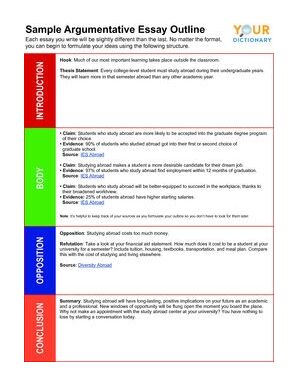
Argumentative essay outline
Key points to remember.
When creating an argumentative essay, you'll want to remember the following:
- Present your argument clearly and without ambiguity.
- Provide background information and substantiate it with facts.
- State your claims and support them with facts.
- Move on to opposing arguments and your responses to them.
Stand Strong in Your Convictions
Although argumentative essays are full of facts, statistics, and data, they are opinion-based. The thing about opinions is that not everyone's going to agree with you. That's why it's important to stand strong in your convictions and do your research. This will allow you to feel confident that you're not stepping out in ignorance on a hot button topic.
Now that you have a solid outline under your belt, check out these argumentative essay writing tips . They'll help you paint a strong picture that will be difficult to refute.

Choose Your Test
Sat / act prep online guides and tips, 3 strong argumentative essay examples, analyzed.
General Education

Need to defend your opinion on an issue? Argumentative essays are one of the most popular types of essays you’ll write in school. They combine persuasive arguments with fact-based research, and, when done well, can be powerful tools for making someone agree with your point of view. If you’re struggling to write an argumentative essay or just want to learn more about them, seeing examples can be a big help.
After giving an overview of this type of essay, we provide three argumentative essay examples. After each essay, we explain in-depth how the essay was structured, what worked, and where the essay could be improved. We end with tips for making your own argumentative essay as strong as possible.
What Is an Argumentative Essay?
An argumentative essay is an essay that uses evidence and facts to support the claim it’s making. Its purpose is to persuade the reader to agree with the argument being made.
A good argumentative essay will use facts and evidence to support the argument, rather than just the author’s thoughts and opinions. For example, say you wanted to write an argumentative essay stating that Charleston, SC is a great destination for families. You couldn’t just say that it’s a great place because you took your family there and enjoyed it. For it to be an argumentative essay, you need to have facts and data to support your argument, such as the number of child-friendly attractions in Charleston, special deals you can get with kids, and surveys of people who visited Charleston as a family and enjoyed it. The first argument is based entirely on feelings, whereas the second is based on evidence that can be proven.
The standard five paragraph format is common, but not required, for argumentative essays. These essays typically follow one of two formats: the Toulmin model or the Rogerian model.
- The Toulmin model is the most common. It begins with an introduction, follows with a thesis/claim, and gives data and evidence to support that claim. This style of essay also includes rebuttals of counterarguments.
- The Rogerian model analyzes two sides of an argument and reaches a conclusion after weighing the strengths and weaknesses of each.
3 Good Argumentative Essay Examples + Analysis
Below are three examples of argumentative essays, written by yours truly in my school days, as well as analysis of what each did well and where it could be improved.
Argumentative Essay Example 1
Proponents of this idea state that it will save local cities and towns money because libraries are expensive to maintain. They also believe it will encourage more people to read because they won’t have to travel to a library to get a book; they can simply click on what they want to read and read it from wherever they are. They could also access more materials because libraries won’t have to buy physical copies of books; they can simply rent out as many digital copies as they need.
However, it would be a serious mistake to replace libraries with tablets. First, digital books and resources are associated with less learning and more problems than print resources. A study done on tablet vs book reading found that people read 20-30% slower on tablets, retain 20% less information, and understand 10% less of what they read compared to people who read the same information in print. Additionally, staring too long at a screen has been shown to cause numerous health problems, including blurred vision, dizziness, dry eyes, headaches, and eye strain, at much higher instances than reading print does. People who use tablets and mobile devices excessively also have a higher incidence of more serious health issues such as fibromyalgia, shoulder and back pain, carpal tunnel syndrome, and muscle strain. I know that whenever I read from my e-reader for too long, my eyes begin to feel tired and my neck hurts. We should not add to these problems by giving people, especially young people, more reasons to look at screens.
Second, it is incredibly narrow-minded to assume that the only service libraries offer is book lending. Libraries have a multitude of benefits, and many are only available if the library has a physical location. Some of these benefits include acting as a quiet study space, giving people a way to converse with their neighbors, holding classes on a variety of topics, providing jobs, answering patron questions, and keeping the community connected. One neighborhood found that, after a local library instituted community events such as play times for toddlers and parents, job fairs for teenagers, and meeting spaces for senior citizens, over a third of residents reported feeling more connected to their community. Similarly, a Pew survey conducted in 2015 found that nearly two-thirds of American adults feel that closing their local library would have a major impact on their community. People see libraries as a way to connect with others and get their questions answered, benefits tablets can’t offer nearly as well or as easily.
While replacing libraries with tablets may seem like a simple solution, it would encourage people to spend even more time looking at digital screens, despite the myriad issues surrounding them. It would also end access to many of the benefits of libraries that people have come to rely on. In many areas, libraries are such an important part of the community network that they could never be replaced by a simple object.
The author begins by giving an overview of the counter-argument, then the thesis appears as the first sentence in the third paragraph. The essay then spends the rest of the paper dismantling the counter argument and showing why readers should believe the other side.
What this essay does well:
- Although it’s a bit unusual to have the thesis appear fairly far into the essay, it works because, once the thesis is stated, the rest of the essay focuses on supporting it since the counter-argument has already been discussed earlier in the paper.
- This essay includes numerous facts and cites studies to support its case. By having specific data to rely on, the author’s argument is stronger and readers will be more inclined to agree with it.
- For every argument the other side makes, the author makes sure to refute it and follow up with why her opinion is the stronger one. In order to make a strong argument, it’s important to dismantle the other side, which this essay does this by making the author's view appear stronger.
- This is a shorter paper, and if it needed to be expanded to meet length requirements, it could include more examples and go more into depth with them, such as by explaining specific cases where people benefited from local libraries.
- Additionally, while the paper uses lots of data, the author also mentions their own experience with using tablets. This should be removed since argumentative essays focus on facts and data to support an argument, not the author’s own opinion or experiences. Replacing that with more data on health issues associated with screen time would strengthen the essay.
- Some of the points made aren't completely accurate , particularly the one about digital books being cheaper. It actually often costs a library more money to rent out numerous digital copies of a book compared to buying a single physical copy. Make sure in your own essay you thoroughly research each of the points and rebuttals you make, otherwise you'll look like you don't know the issue that well.

Argumentative Essay Example 2
There are multiple drugs available to treat malaria, and many of them work well and save lives, but malaria eradication programs that focus too much on them and not enough on prevention haven’t seen long-term success in Sub-Saharan Africa. A major program to combat malaria was WHO’s Global Malaria Eradication Programme. Started in 1955, it had a goal of eliminating malaria in Africa within the next ten years. Based upon previously successful programs in Brazil and the United States, the program focused mainly on vector control. This included widely distributing chloroquine and spraying large amounts of DDT. More than one billion dollars was spent trying to abolish malaria. However, the program suffered from many problems and in 1969, WHO was forced to admit that the program had not succeeded in eradicating malaria. The number of people in Sub-Saharan Africa who contracted malaria as well as the number of malaria deaths had actually increased over 10% during the time the program was active.
One of the major reasons for the failure of the project was that it set uniform strategies and policies. By failing to consider variations between governments, geography, and infrastructure, the program was not nearly as successful as it could have been. Sub-Saharan Africa has neither the money nor the infrastructure to support such an elaborate program, and it couldn’t be run the way it was meant to. Most African countries don't have the resources to send all their people to doctors and get shots, nor can they afford to clear wetlands or other malaria prone areas. The continent’s spending per person for eradicating malaria was just a quarter of what Brazil spent. Sub-Saharan Africa simply can’t rely on a plan that requires more money, infrastructure, and expertise than they have to spare.
Additionally, the widespread use of chloroquine has created drug resistant parasites which are now plaguing Sub-Saharan Africa. Because chloroquine was used widely but inconsistently, mosquitoes developed resistance, and chloroquine is now nearly completely ineffective in Sub-Saharan Africa, with over 95% of mosquitoes resistant to it. As a result, newer, more expensive drugs need to be used to prevent and treat malaria, which further drives up the cost of malaria treatment for a region that can ill afford it.
Instead of developing plans to treat malaria after the infection has incurred, programs should focus on preventing infection from occurring in the first place. Not only is this plan cheaper and more effective, reducing the number of people who contract malaria also reduces loss of work/school days which can further bring down the productivity of the region.
One of the cheapest and most effective ways of preventing malaria is to implement insecticide-treated bed nets (ITNs). These nets provide a protective barrier around the person or people using them. While untreated bed nets are still helpful, those treated with insecticides are much more useful because they stop mosquitoes from biting people through the nets, and they help reduce mosquito populations in a community, thus helping people who don’t even own bed nets. Bed nets are also very effective because most mosquito bites occur while the person is sleeping, so bed nets would be able to drastically reduce the number of transmissions during the night. In fact, transmission of malaria can be reduced by as much as 90% in areas where the use of ITNs is widespread. Because money is so scarce in Sub-Saharan Africa, the low cost is a great benefit and a major reason why the program is so successful. Bed nets cost roughly 2 USD to make, last several years, and can protect two adults. Studies have shown that, for every 100-1000 more nets are being used, one less child dies of malaria. With an estimated 300 million people in Africa not being protected by mosquito nets, there’s the potential to save three million lives by spending just a few dollars per person.
Reducing the number of people who contract malaria would also reduce poverty levels in Africa significantly, thus improving other aspects of society like education levels and the economy. Vector control is more effective than treatment strategies because it means fewer people are getting sick. When fewer people get sick, the working population is stronger as a whole because people are not put out of work from malaria, nor are they caring for sick relatives. Malaria-afflicted families can typically only harvest 40% of the crops that healthy families can harvest. Additionally, a family with members who have malaria spends roughly a quarter of its income treatment, not including the loss of work they also must deal with due to the illness. It’s estimated that malaria costs Africa 12 billion USD in lost income every year. A strong working population creates a stronger economy, which Sub-Saharan Africa is in desperate need of.
This essay begins with an introduction, which ends with the thesis (that malaria eradication plans in Sub-Saharan Africa should focus on prevention rather than treatment). The first part of the essay lays out why the counter argument (treatment rather than prevention) is not as effective, and the second part of the essay focuses on why prevention of malaria is the better path to take.
- The thesis appears early, is stated clearly, and is supported throughout the rest of the essay. This makes the argument clear for readers to understand and follow throughout the essay.
- There’s lots of solid research in this essay, including specific programs that were conducted and how successful they were, as well as specific data mentioned throughout. This evidence helps strengthen the author’s argument.
- The author makes a case for using expanding bed net use over waiting until malaria occurs and beginning treatment, but not much of a plan is given for how the bed nets would be distributed or how to ensure they’re being used properly. By going more into detail of what she believes should be done, the author would be making a stronger argument.
- The introduction of the essay does a good job of laying out the seriousness of the problem, but the conclusion is short and abrupt. Expanding it into its own paragraph would give the author a final way to convince readers of her side of the argument.

Argumentative Essay Example 3
There are many ways payments could work. They could be in the form of a free-market approach, where athletes are able to earn whatever the market is willing to pay them, it could be a set amount of money per athlete, or student athletes could earn income from endorsements, autographs, and control of their likeness, similar to the way top Olympians earn money.
Proponents of the idea believe that, because college athletes are the ones who are training, participating in games, and bringing in audiences, they should receive some sort of compensation for their work. If there were no college athletes, the NCAA wouldn’t exist, college coaches wouldn’t receive there (sometimes very high) salaries, and brands like Nike couldn’t profit from college sports. In fact, the NCAA brings in roughly $1 billion in revenue a year, but college athletes don’t receive any of that money in the form of a paycheck. Additionally, people who believe college athletes should be paid state that paying college athletes will actually encourage them to remain in college longer and not turn pro as quickly, either by giving them a way to begin earning money in college or requiring them to sign a contract stating they’ll stay at the university for a certain number of years while making an agreed-upon salary.
Supporters of this idea point to Zion Williamson, the Duke basketball superstar, who, during his freshman year, sustained a serious knee injury. Many argued that, even if he enjoyed playing for Duke, it wasn’t worth risking another injury and ending his professional career before it even began for a program that wasn’t paying him. Williamson seems to have agreed with them and declared his eligibility for the NCAA draft later that year. If he was being paid, he may have stayed at Duke longer. In fact, roughly a third of student athletes surveyed stated that receiving a salary while in college would make them “strongly consider” remaining collegiate athletes longer before turning pro.
Paying athletes could also stop the recruitment scandals that have plagued the NCAA. In 2018, the NCAA stripped the University of Louisville's men's basketball team of its 2013 national championship title because it was discovered coaches were using sex workers to entice recruits to join the team. There have been dozens of other recruitment scandals where college athletes and recruits have been bribed with anything from having their grades changed, to getting free cars, to being straight out bribed. By paying college athletes and putting their salaries out in the open, the NCAA could end the illegal and underhanded ways some schools and coaches try to entice athletes to join.
People who argue against the idea of paying college athletes believe the practice could be disastrous for college sports. By paying athletes, they argue, they’d turn college sports into a bidding war, where only the richest schools could afford top athletes, and the majority of schools would be shut out from developing a talented team (though some argue this already happens because the best players often go to the most established college sports programs, who typically pay their coaches millions of dollars per year). It could also ruin the tight camaraderie of many college teams if players become jealous that certain teammates are making more money than they are.
They also argue that paying college athletes actually means only a small fraction would make significant money. Out of the 350 Division I athletic departments, fewer than a dozen earn any money. Nearly all the money the NCAA makes comes from men’s football and basketball, so paying college athletes would make a small group of men--who likely will be signed to pro teams and begin making millions immediately out of college--rich at the expense of other players.
Those against paying college athletes also believe that the athletes are receiving enough benefits already. The top athletes already receive scholarships that are worth tens of thousands per year, they receive free food/housing/textbooks, have access to top medical care if they are injured, receive top coaching, get travel perks and free gear, and can use their time in college as a way to capture the attention of professional recruiters. No other college students receive anywhere near as much from their schools.
People on this side also point out that, while the NCAA brings in a massive amount of money each year, it is still a non-profit organization. How? Because over 95% of those profits are redistributed to its members’ institutions in the form of scholarships, grants, conferences, support for Division II and Division III teams, and educational programs. Taking away a significant part of that revenue would hurt smaller programs that rely on that money to keep running.
While both sides have good points, it’s clear that the negatives of paying college athletes far outweigh the positives. College athletes spend a significant amount of time and energy playing for their school, but they are compensated for it by the scholarships and perks they receive. Adding a salary to that would result in a college athletic system where only a small handful of athletes (those likely to become millionaires in the professional leagues) are paid by a handful of schools who enter bidding wars to recruit them, while the majority of student athletics and college athletic programs suffer or even shut down for lack of money. Continuing to offer the current level of benefits to student athletes makes it possible for as many people to benefit from and enjoy college sports as possible.
This argumentative essay follows the Rogerian model. It discusses each side, first laying out multiple reasons people believe student athletes should be paid, then discussing reasons why the athletes shouldn’t be paid. It ends by stating that college athletes shouldn’t be paid by arguing that paying them would destroy college athletics programs and cause them to have many of the issues professional sports leagues have.
- Both sides of the argument are well developed, with multiple reasons why people agree with each side. It allows readers to get a full view of the argument and its nuances.
- Certain statements on both sides are directly rebuffed in order to show where the strengths and weaknesses of each side lie and give a more complete and sophisticated look at the argument.
- Using the Rogerian model can be tricky because oftentimes you don’t explicitly state your argument until the end of the paper. Here, the thesis doesn’t appear until the first sentence of the final paragraph. That doesn’t give readers a lot of time to be convinced that your argument is the right one, compared to a paper where the thesis is stated in the beginning and then supported throughout the paper. This paper could be strengthened if the final paragraph was expanded to more fully explain why the author supports the view, or if the paper had made it clearer that paying athletes was the weaker argument throughout.

3 Tips for Writing a Good Argumentative Essay
Now that you’ve seen examples of what good argumentative essay samples look like, follow these three tips when crafting your own essay.
#1: Make Your Thesis Crystal Clear
The thesis is the key to your argumentative essay; if it isn’t clear or readers can’t find it easily, your entire essay will be weak as a result. Always make sure that your thesis statement is easy to find. The typical spot for it is the final sentence of the introduction paragraph, but if it doesn’t fit in that spot for your essay, try to at least put it as the first or last sentence of a different paragraph so it stands out more.
Also make sure that your thesis makes clear what side of the argument you’re on. After you’ve written it, it’s a great idea to show your thesis to a couple different people--classmates are great for this. Just by reading your thesis they should be able to understand what point you’ll be trying to make with the rest of your essay.
#2: Show Why the Other Side Is Weak
When writing your essay, you may be tempted to ignore the other side of the argument and just focus on your side, but don’t do this. The best argumentative essays really tear apart the other side to show why readers shouldn’t believe it. Before you begin writing your essay, research what the other side believes, and what their strongest points are. Then, in your essay, be sure to mention each of these and use evidence to explain why they’re incorrect/weak arguments. That’ll make your essay much more effective than if you only focused on your side of the argument.
#3: Use Evidence to Support Your Side
Remember, an essay can’t be an argumentative essay if it doesn’t support its argument with evidence. For every point you make, make sure you have facts to back it up. Some examples are previous studies done on the topic, surveys of large groups of people, data points, etc. There should be lots of numbers in your argumentative essay that support your side of the argument. This will make your essay much stronger compared to only relying on your own opinions to support your argument.
Summary: Argumentative Essay Sample
Argumentative essays are persuasive essays that use facts and evidence to support their side of the argument. Most argumentative essays follow either the Toulmin model or the Rogerian model. By reading good argumentative essay examples, you can learn how to develop your essay and provide enough support to make readers agree with your opinion. When writing your essay, remember to always make your thesis clear, show where the other side is weak, and back up your opinion with data and evidence.
What's Next?
Do you need to write an argumentative essay as well? Check out our guide on the best argumentative essay topics for ideas!
You'll probably also need to write research papers for school. We've got you covered with 113 potential topics for research papers.
Your college admissions essay may end up being one of the most important essays you write. Follow our step-by-step guide on writing a personal statement to have an essay that'll impress colleges.

Christine graduated from Michigan State University with degrees in Environmental Biology and Geography and received her Master's from Duke University. In high school she scored in the 99th percentile on the SAT and was named a National Merit Finalist. She has taught English and biology in several countries.
Student and Parent Forum
Our new student and parent forum, at ExpertHub.PrepScholar.com , allow you to interact with your peers and the PrepScholar staff. See how other students and parents are navigating high school, college, and the college admissions process. Ask questions; get answers.

Ask a Question Below
Have any questions about this article or other topics? Ask below and we'll reply!
Improve With Our Famous Guides
- For All Students
The 5 Strategies You Must Be Using to Improve 160+ SAT Points
How to Get a Perfect 1600, by a Perfect Scorer
Series: How to Get 800 on Each SAT Section:
Score 800 on SAT Math
Score 800 on SAT Reading
Score 800 on SAT Writing
Series: How to Get to 600 on Each SAT Section:
Score 600 on SAT Math
Score 600 on SAT Reading
Score 600 on SAT Writing
Free Complete Official SAT Practice Tests
What SAT Target Score Should You Be Aiming For?
15 Strategies to Improve Your SAT Essay
The 5 Strategies You Must Be Using to Improve 4+ ACT Points
How to Get a Perfect 36 ACT, by a Perfect Scorer
Series: How to Get 36 on Each ACT Section:
36 on ACT English
36 on ACT Math
36 on ACT Reading
36 on ACT Science
Series: How to Get to 24 on Each ACT Section:
24 on ACT English
24 on ACT Math
24 on ACT Reading
24 on ACT Science
What ACT target score should you be aiming for?
ACT Vocabulary You Must Know
ACT Writing: 15 Tips to Raise Your Essay Score
How to Get Into Harvard and the Ivy League
How to Get a Perfect 4.0 GPA
How to Write an Amazing College Essay
What Exactly Are Colleges Looking For?
Is the ACT easier than the SAT? A Comprehensive Guide
Should you retake your SAT or ACT?
When should you take the SAT or ACT?
Stay Informed
Get the latest articles and test prep tips!
Looking for Graduate School Test Prep?
Check out our top-rated graduate blogs here:
GRE Online Prep Blog
GMAT Online Prep Blog
TOEFL Online Prep Blog
Holly R. "I am absolutely overjoyed and cannot thank you enough for helping me!”
22+ Sample Argumentative Essay In MS Word | Google Docs | Google Slides | PowerPoint | Illustrator | PDF

Argumentative Essay In MS Word | Google Docs | Google Slides | PowerPoint | Illustrator | PDF
22+ sample argumentative essay, what is an argumentative essay, examples of argumentative essay topics, how to write a well-structured argumentative essay, where can i find sample argumentative essays for middle school or college, how can sample argumentative essays help me in writing my own essay, what are some popular argumentative essay topics related to social media, how should i create an outline for my argumentative essay, are there specific guidelines for formatting and citation in argumentative essays, how can i choose a suitable argumentative essay topic for college, can i use sample argumentative essays as my own work.
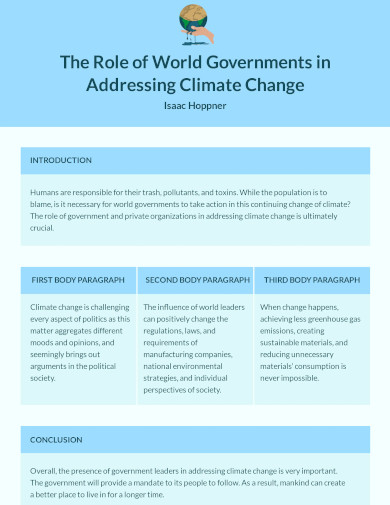
Argumentative Essay Graphic Organizer Template
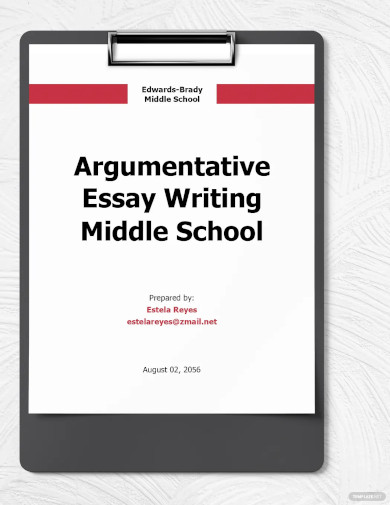
Argumentative Essay Writing Middle School Template
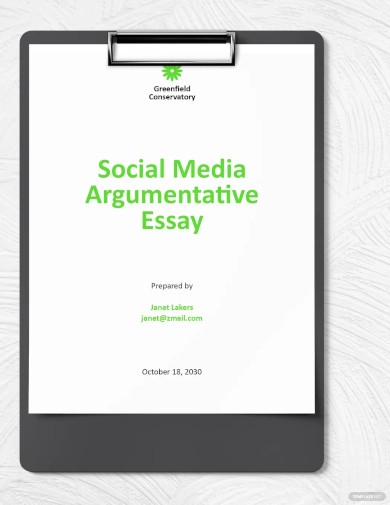
Social Media Argumentative Essay Template
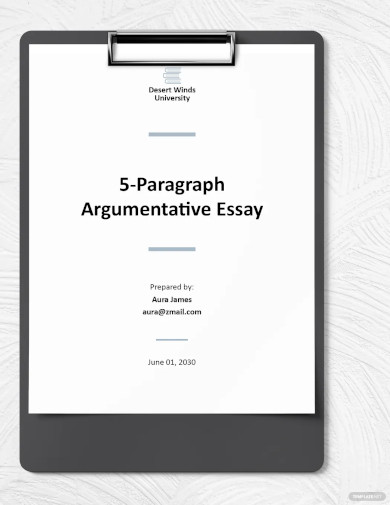
5-Paragraph Argumentative Essay Template
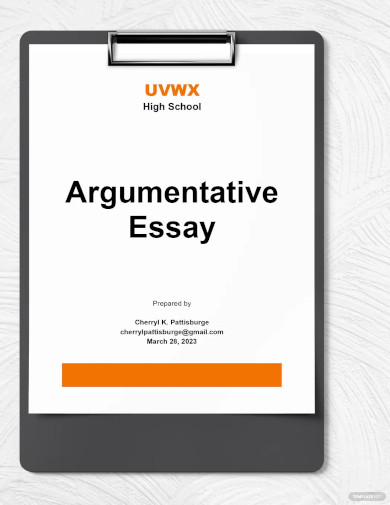
Argumentative Essay Outline Template
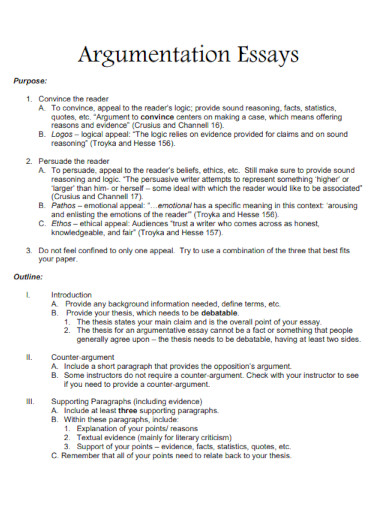
Sample Argumentation Essays
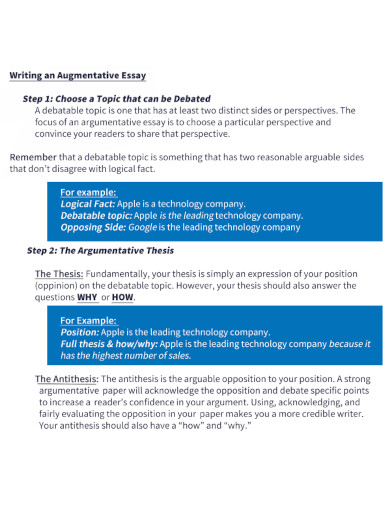
Writing Argumentation Essay

Argumentative Persuasive Essay

Analytical Argumentative Essay

Argumentative vs Informative Essays
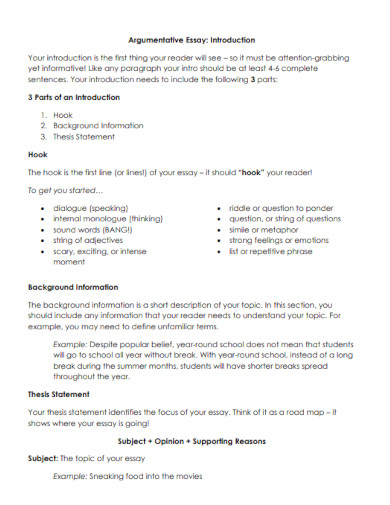
Argumentative Essay with Introduction
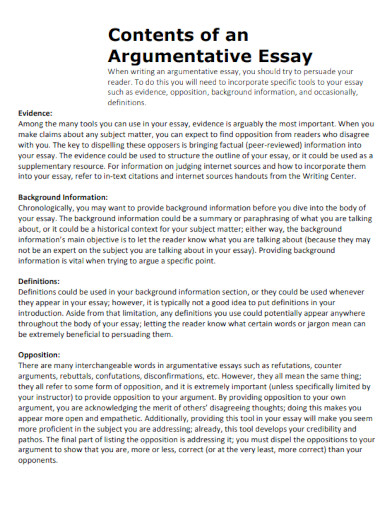
Contents of an Argumentative Essay
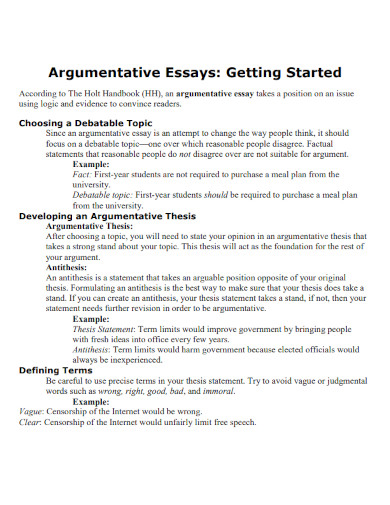
College Argumentative Essays
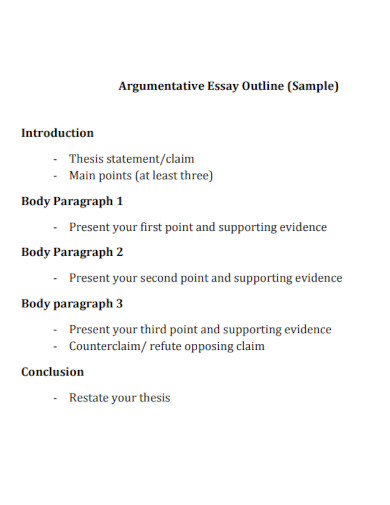
Sample Argumentative Essay Outline
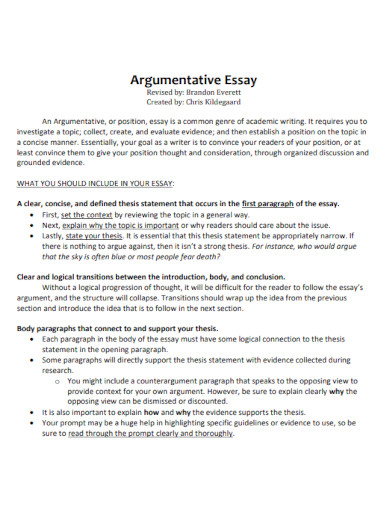
University Argumentative Essay

Argumentative Essay Structure

8th Grade Argumentative Essay
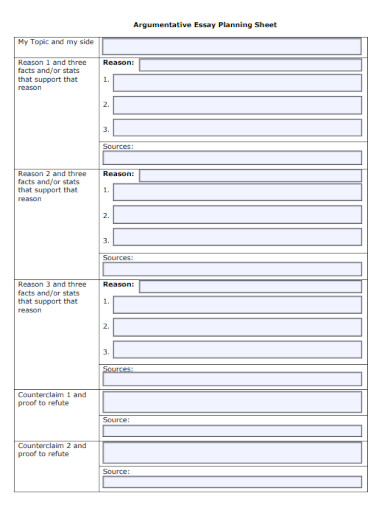
Argumentative Essay Planning Sheet

Easy Argumentative Essay
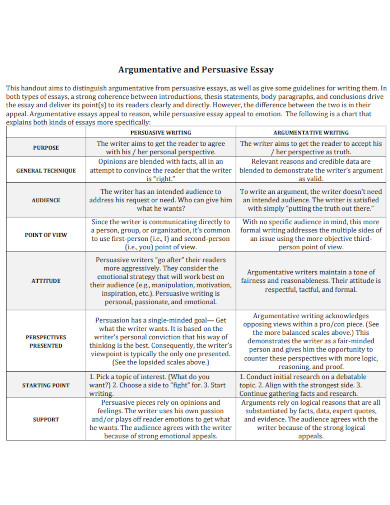
Argumentative and Persuasive Essay
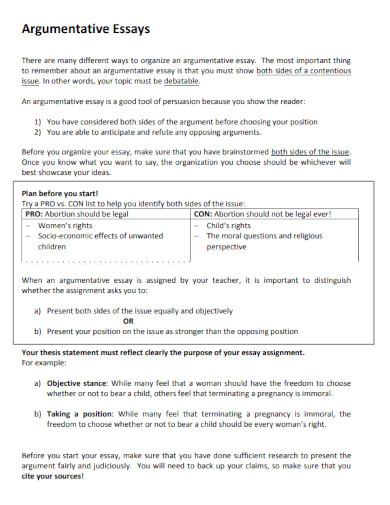
Thesis Argumentative Essay
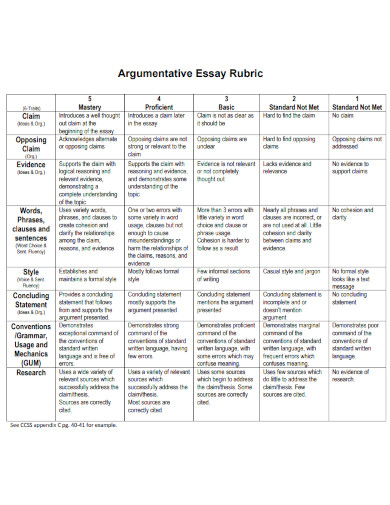
Argumentative Essay Rubric
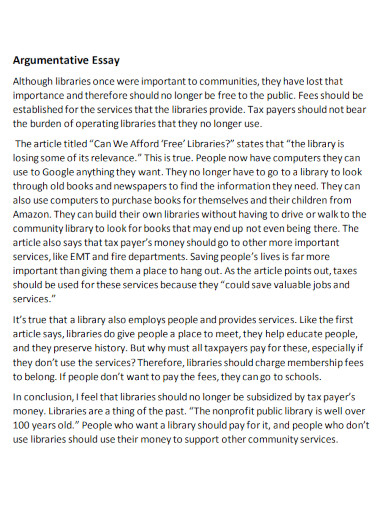
Short Argumentative Essay
Step 1: select a topic, step 2: conduct research, step 3: create an outline, step 4: write the essay, step 5: revise and edit your argumentative essay, share this post on your network, you may also like these articles, 10+ sample community college essay in pdf | ms word.

George Bernard Shaw, a famous Irish playwright, once said, “I am of the opinion that my life belongs to the community, and as long as I live, it is…
23+ SAMPLE Admission Essay in PDF

Our way to college is exciting. Finally, young students are there where they are about to begin their journey near to adulthood. They begin to feel free. They are…
browse by categories
- Questionnaire
- Description
- Reconciliation
- Certificate
- Spreadsheet
Information
- privacy policy
- Terms & Conditions
Argumentative Essay
Create a Compelling Argumentative Essay on Any Topic with Our Professionally-written Argumentative Essay Templates. Get Ready-made Document Examples in Blank, Simple, Basic, or Formal Outlines of Argumentative Essay Format, 5-Paragraph Argumentative Essay, and Argumentative Essay Graphic Organizer Templates. Edit Content Easily Using Our Editor Tool, Download for Free, and Print Instantly.
Get Access to All Templates


IMAGES
VIDEO
COMMENTS
Some paragraphs introduce your own argument, while others state the opposing arguments and their refutations. Here is an argumentative essay outline template you could follow for writing your essay: The most common structure to craft an argumentative essay is as follows: 1. Argumentative Essay Introduction.
Make a claim. Provide the grounds (evidence) for the claim. Explain the warrant (how the grounds support the claim) Discuss possible rebuttals to the claim, identifying the limits of the argument and showing that you have considered alternative perspectives. The Toulmin model is a common approach in academic essays.
Refuting Opponents' Arguments. Opposing view 1. Refutation 1. Opposing view 2. Refutation 2. Conclusion. Restate the importance of your issue. Paint a picture of the world depicting what would happen if your argument is (or is not) implemented. For more information on how to use this argumentative outline for your next essay, read How to ...
IV. Counter-Claim Paragraph : Argument Essays must have a Counter-Claim!!! A.COUNTER-CLAIM • PICK AND USE A COUNTER-CLAIM SENTENCE STARTER. B. Explain • claim that "state the opposing side's Why the Counter-claim argument is weak. Counter-claim Sentence Starters • People who disagree may claim that
Argumentative Essay Revised by: Brandon Everett Created by: Chris Kildegaard Revised, Fall 2019 An Argumentative, or position, essay is a common genre of academic writing. It requires you to investigate a topic; collect, create, and evaluate evidence; and then establish a position on the topic in a concise manner.
C. Paragraph 4 - Reason #3 and Evidence Continue with Reason #4 and so on if needed before the Objection/Rebuttal paragraph. Topic sentence
Argumentative essay formula & example. In the image below, you can see a recommended structure for argumentative essays. It starts with the topic sentence, which establishes the main idea of the essay. Next, this hypothesis is developed in the development stage. Then, the rebuttal, or the refutal of the main counter argument or arguments.
An argumentative essay comprises five essential components: 1. Claim. Claim in argumentative writing is the central argument or viewpoint that the writer aims to establish and defend throughout the essay. A claim must assert your position on an issue and must be arguable. It can guide the entire argument.
Revised on July 23, 2023. An essay outline is a way of planning the structure of your essay before you start writing. It involves writing quick summary sentences or phrases for every point you will cover in each paragraph, giving you a picture of how your argument will unfold. You'll sometimes be asked to submit an essay outline as a separate ...
An Argumentative Essay takes a position on an issue and tries to convince the reader that this position is correct whereas an argumentative essay outline gives proper structure to the essay before it is written.. Built on an initial premise, every section in the paper reinforces the declared statement as correct. Ideally, by the time one is at the conclusion, a strong paper will have won over ...
When writing an argumentative essay outline, it's important to have all your facts straight. More than any other type of essay, you need to have solid and verifiable sources. ... Check out this downloadable outline to see how you create an argumentative essay in action. And, the document is totally editable. Argumentative essay outline Click to ...
Developing an argument requires a significant understanding of the subject matter from all angles. Let's take a look at the steps to writing an argumentative essay: 1. Choose appropriate argumentative essay topics. Although topics for an argumentative essay are highly diverse, they are based on a controversial stance.
Sample Essay Outline Templates. Essay Outlines. In line with your dilemma, we've provided you here an array of argumentative essay templates that will help you kick-start your argumentative essays. These types of essays require thorough research because you'll need to defend your stand. Feel free to scroll down and check out our templates.
Body paragraph 3. Reason #3. Supporting fact or example 1. Supporting fact or example 2. Conclusion. Brief summary of the topic. Benefits to the reader. Call to action. For more information on how to use this persuasive outline for your next essay, read " How to Create a Persuasive Essay Outline .".
Essay outlines can be used for any college essay, research papers, a contrast essay, speech writing, or an expository essay. There are a range of essay outline templates to use, and they vary depending on the style of essay you are writing. These include: Argumentative essay outline. Narrative essay outline. Contrast essay outline.
Argumentative Essay Outline. depts.washington.edu. Download Now. It may come as a surprise for you to find out that you do not have to write "argument" as a reminder if you are writing something that involves argument in your academic or business task. Making an argument or expressing your stand on a specific subject with facts and evidence ...
In the search box, just type "argumentative essay" or "argumentative essay templates." There's also a possibility that other types of essay templates will show up such as research paper essays and narrative essays. Step 3: Select an Argumentative Essay Template. Click the image of the argumentative essay template that you want.
Essay Outline Template. I. Introduction. a. General Background Information (1-2 sentences) i. Attention grabbing intro. ii. Who, What, When, Where - establish topic. b. Write your Thesis Statement i. an arguable sentence, which is debatable and worth proving c. Summarize Body Paragraph Sub-points / Arguments (1 sentence)
Argumentative Essay Example 2. Malaria is an infectious disease caused by parasites that are transmitted to people through female Anopheles mosquitoes. Each year, over half a billion people will become infected with malaria, with roughly 80% of them living in Sub-Saharan Africa.
Instantly Download Argumentative Essay Format Template in Word, Google Docs. ... Sample & Example in Word, Google Docs, PDF Format. Available in US sizes. Quickly Customize. Easily Editable & Printable. Get Access to the World's Largest Template Library & Tools. Download Now. Argumentative Essay Format Template. Share to Pinterest Share to ...
Our comprehensive PDF and MS Word document offer sample argumentative essay topics and examples, including the influence of social media, as well as college essays, an admission essay, or a college application personal statement. Engage in this valuable resource to excel in your academic journey.
ENG 190 Module Four Persuasive Essay Outline Template. Directions for Using the Outline An outline is a tool that writers use to organize their ideas. For some writers, it works best to write out all their ideas and then organize them. For other writers, it works best to organize and then draft.
Create a Compelling Argumentative Essay on Any Topic with Our Professionally-written Argumentative Essay Templates. Get Ready-made Document Examples in Blank, Simple, Basic, or Formal Outlines of Argumentative Essay Format, 5-Paragraph Argumentative Essay, and Argumentative Essay Graphic Organizer Templates. Edit Content Easily Using Our Editor Tool, Download for Free, and Print Instantly.